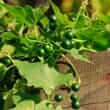Background
- White bryony (Bryonia alba and Bryonia dioica) is a perennial, climbing herb with flowers and lobed leaves that resemble an open hand. The plant's berries are considered poisonous.
- The root of white bryony has been extracted with alcohol and used at very low doses in homeopathic medications for fevers and dry mouth, respiratory infections, gastrointestinal disorders, and joint pain (applied to the skin). Some homeopathic practitioners believe that the patients who may experience the best outcome with bryony treatment are those who are initially reluctant to move or speak and who feel irritable and weary.
- However, the homeopathic medicine bryonia was correctly identified only 48.1% of the time by homeopaths when compared with a placebo-containing bottle. In separate research, 60% of homeopaths correctly identified the bottle containing bryonia.
- Limited research has shown that white bryony may have analgesic (pain-reducing), anti-inflammatory, and antimicrobial effects. However, clinical studies in humans are lacking.
References
- Gupta M, Mazumdar UK, Sivakumar T, et al. Evaluation of anti-inflammatory activity of chloroform extract of Bryonia laciniosa in experimental animal models. Biol.Pharm.Bull. 2003;26(9):1342-1344. View Abstract
- Karageuzyan KG, Vartanyan GS, Agadjanov MI, Panossian AG, Hoult JR. Restoration of the disordered glucose-fatty acid cycle in alloxan-diabetic rats by trihydroxyoctadecadienoic acids from Bryonia alba, a native Armenian medicinal plant. Planta Med. 1998;64(5):417-422. View Abstract
- Khan MT, Choudhary MI, Atta-ur-Rahman, et al. Tyrosinase inhibition studies of cycloartane and cucurbitane glycosides and their structure-activity relationships. Bioorg.Med Chem 9-1-2006;14(17):6085-6088. View Abstract
- Mahasneh AM, El Oqlah AA. Antimicrobial activity of extracts of herbal plants used in the traditional medicine of Jordan. J.Ethnopharmacol. 1999;64(3):271-276. View Abstract
- McCarney R, Fisher P, Spink F, Flint G, van Haselen R. Can homeopaths detect homeopathic medicines by dowsing? A randomized, double-blind, placebo-controlled trial. J.R.Soc.Med. 2002;95(4):189-191. View Abstract
- Paris A, Gonnet N, Chaussard C, et al. Effect of homeopathy on analgesic intake following knee ligament reconstruction: a phase III monocentre randomized placebo controlled study. Br J Clin Pharmacol 2008;65(2):180-187. View Abstract
- Pieroni A. Medicinal plants and food medicines in the folk traditions of the upper Lucca Province, Italy. J.Ethnopharmacol. 2000;70(3):235-273. View Abstract
- Seligmann IC, Lima PD, Cardoso PC, et al. The anticancer homeopathic composite "Canova Method" is not genotoxic for human lymphocytes in vitro. Genet.Mol.Res. 6-30-2003;2(2):223-228. View Abstract
- Sivakumar T, Perumal P, Kumar RS, et al. Evaluation of analgesic, antipyretic activity and toxicity study of Bryonia laciniosa in mice and rats. Am.J.Chin Med. 2004;32(4):531-539. View Abstract
- Suganda AG, Amoros M, Girre L, Fauconnier B. [Inhibitory effects of some crude and semi-purified extracts of indigenous French plants on the multiplication of human herpesvirus 1 and poliovirus 2 in cell culture]. J.Nat.Prod. 1983;46(5):626-632. View Abstract
- Varshney JP, Naresh R. Comparative efficacy of homeopathic and allopathic systems of medicine in the management of clinical mastitis of Indian dairy cows. Homeopathy 2005;94(2):81-85. View Abstract







